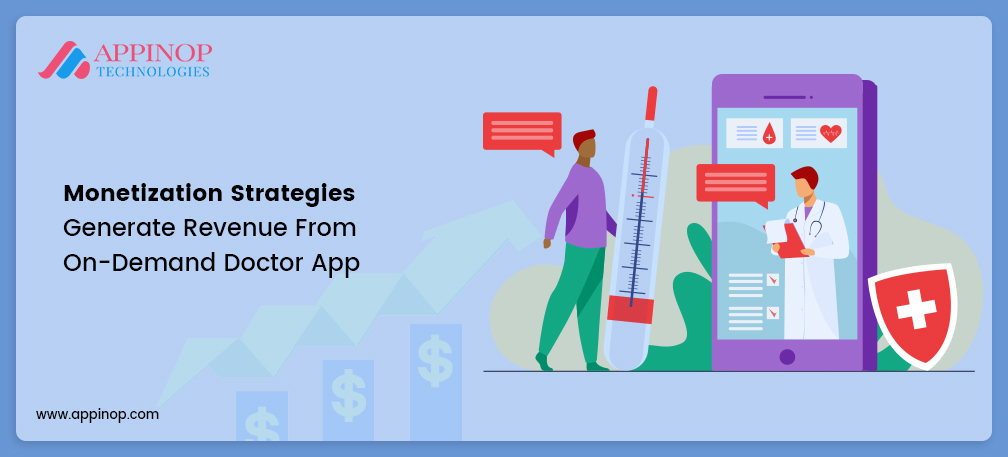
Monetization Strategies: 8 Ways To Generate Revenue From On-Demand Doctor App
The mobile app market is growing exponentially in the world. People devote countless hours to their smartphones and other mobile devices every day. This brings immense opportunities for app owners to generate revenue from their services.
There are various methods that you can incorporate to generate revenue from your healthcare app. Some app owners go with a single monetization approach, while others implement a hybrid approach.
In this blog, we would be talking about possible ways of app monetization. Go through the blog to familiarize yourself with all of these approaches and chalk out your monetization plan that best fits with your online health service platform.
- Freemium
Freemium is one of the leading monetization models to generate revenue from your online health service platform. If we segregate the word “Freemium” then two terms come out- “free” and “premium”.
In this model, you offer two versions of an on-demand doctor app. The free version offers basic features to your app users and the premium one allows your app users to access advanced features that are not present in the free version.
The motto behind this model is that users will download the free version and get a good experience that they would willing to pay for the premium version to access extra value-added features. To cut a long explanation short, the freemium model offers a chance to know your health service before making payment.
- Sponsorship
A sponsor in your app has an icon that is visible to your app users just after its launch. The strategy here is to connect with potential influencers and sponsors from a medical network. Here, you don’t pay influencers. Instead, if your on-demand doctor app service has a large customer base and has a high engagement rate, you can offer products or services of your influencers to your customers. And this helps you to earn some amount of money.
- Health Data Licensing
Do not forget that data is a goldmine for any business to make an effective strategy. So, if your online health service platform has functionality that gathers user-generated data related to doctors and patients, then you should consider licensing your actionable data to other businesses. This way you can monetize your app via its data licensing. For example, MedData Group provides demographics, clinical behavior (Dx, Px, and Rx data) and complete contact details including email and digital IDs to vendors.
- Registration fees
As a health service provider, you can generate revenue from your on-demand doctor app by charging registration fee from your new users.
- Subscription Charges
The subscription monetization model is a revenue model that charges doctors and patients a recurring amount — typically monthly, quarterly or yearly — to access health-related service. As long as your app users continue to see the benefits your healthcare enterprise offers to them, they’ll continue to pay you for it.
The subscription business model works well with strong and long-lasting customer relationships. The more you know your customers, the better you keep your company in sync with their needs and expectations.
- Paid Content
Paid content is another one of the effective monetization strategies that work well for apps that provide peer-to-peer healthcare services and aim at selling informative content that would add value to healthcare providers’ practice rather than promotional content. With this approach, doctors and other medical staff able to read a portion of the content for free. Thereafter, they need to subscribe and make recurring payment (monthly, quarterly or yearly) to get complete access to read content related to medical updates and advancements.
- Affiliate Ads
Affiliate ads are one of the app monetization models to generate money by collaborating with another company. Here you advertise its services or products within your healthcare app and earn a commission on it. But to make this model successful, you need to pick up health services that can complement your app for your user base.
- Paid Ad
During the earlier days, when app stores were just launched, the paid ad monetization model was the only revenue model. With this model, the app publisher generated revenue each time the app was downloaded. Later, this model reduced. Still, for many app categories, the paid app model works well.
Final Thoughts
This blog talked about the seven popular revenue models for mobile health care apps. In order to know which revenue model works for you and how to earn money from mobile apps including the healthcare app, you have to analyze the online health platform you’re building and the features you are developing in it.
You can implement a single monetization strategy or even you can combine multiple strategies for effective monetization.
At Appinop, we specialize in building secure and feature-rich on-demand doctor apps. We are passionate to add value to the healthcare industry through our incredible digital solutions. If you are looking to create an online health service platform and require a trusted app development company then reach out to our experts with your app idea. We’ll be glad to help you from building an app to the launching of your healthcare app to marketing & promoting your app.
Abhinav Chatterji
Abhinav Chatterji is part of the Digital Marketing team at Appinop Technologies. With a fine ability to craft writing pieces that present unique and fresher thought perspectives on different technology and business innovation factors, he creates content that connects with users. His deep-researched theories and valuable insights on industry-wide topics illustrate his accomplished writing portfolio. Product reviews, cost factor analysis, subject reasoning, and dissecting technologies are his power-traits.




